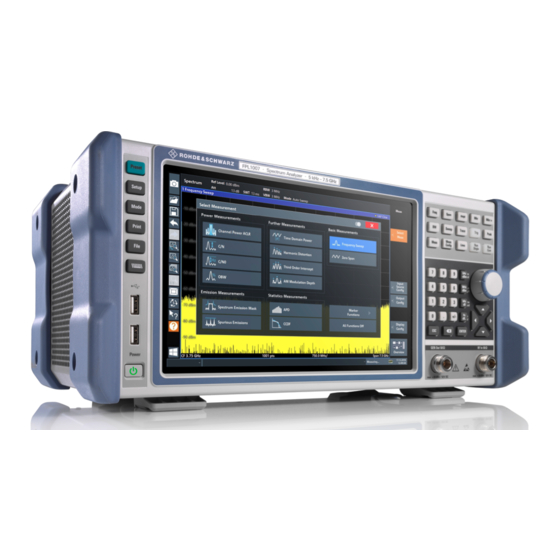
Summarization of Contents
Safety and Regulatory Information
Safety Instructions
Provides essential safety guidelines for the proper and safe use of the instrument.
Labels on R&S FPL1000
Explains the meaning of safety and identification labels found on the instrument casing.
Korea Certification Class A
Information regarding Korea Certification Class A for electronic devices.
Documentation Overview
Getting Started Manual
Introduces the R&S FPL1000, covering setup, basic operations, and general information.
User Manuals and Help
Details the available user manuals and integrated help system for the instrument.
Service Manual
Describes performance tests, module replacement, repair, and firmware updates.
Instrument Security Procedures
Covers security issues when operating the instrument in secure environments.
Printed Safety Instructions
Provides safety information in multiple languages, delivered with the product.
Data Sheets and Brochures
Contains technical specifications, firmware applications, and optional accessories.
Release Notes and Open Source Acknowledgment (OSA)
Lists new features, improvements, known issues, and open source licenses.
Application Notes, Application Cards, White Papers, etc.
Offers documents on special applications and background information.
Calibration Certificate
Information on obtaining the calibration certificate for the instrument.
Preparing for Use
Lifting and Carrying
Provides instructions on safely lifting and carrying the R&S FPL1000 instrument.
Unpacking and Checking
Guides through the process of unpacking and verifying the instrument's completeness.
Choosing the Operating Site
Details factors for selecting an appropriate operating location for the instrument.
Setting Up the R&S FPL1000
Covers the procedures for setting up the R&S FPL1000 on a bench top or in a rack.
Connecting to Power
Explains how to connect the instrument to AC, DC, or battery power sources.
Switching On or Off
Describes the procedure for switching the instrument on and off, including power states.
Connecting to LAN
Details how to connect the instrument to a Local Area Network for remote operation.
Connecting a Keyboard
Explains how to connect an external keyboard and configure its language settings.
Connecting an External Monitor
Guides on connecting an external monitor or projector for an enlarged display.
Windows Operating System
Discusses the instrument's Windows OS, system setup, and software considerations.
Logging On
Explains user account management and the auto-login function for the instrument.
Checking the Supplied Options
Provides steps to verify installed hardware and firmware options against the delivery note.
Performing a Self-Alignment
Describes the self-alignment procedure for instrument calibration and accuracy.
Considerations for Test Setup
Offers advice on cable selection, EMI, and ESD prevention for optimal test setup.
Instrument Tour
Front Panel View
Details the front panel components, including keys, connectors, and touchscreen.
Rear Panel View
Illustrates and describes the connectors and ports on the rear panel of the instrument.
Trying Out the Instrument
Measuring a Basic Signal
Guides through measuring a basic signal using the internal calibration signal.
Displaying a Spectrogram
Explains how to display a spectrogram, showing spectral density over time.
Activating Additional Measurement Channels
Demonstrates activating multiple measurement channels for different analysis tasks.
Performing Sequential Measurements
Covers setting up and performing sequential measurements using the Sequencer.
Setting and Moving a Marker
Details how to set, move, and use markers for signal analysis on traces.
Displaying a Marker Peak List
Explains how to display a list of identified peaks in the spectrum.
Zooming into the Display
Guides on using zoom functions to analyze specific areas of the displayed signal.
Saving Settings
Describes how to save instrument settings and configurations to a file.
Printing and Saving Results
Covers exporting trace data and creating screenshots of the instrument display.
Operating the Instrument
Understanding the Display Information - Spectrum Mode
Explains how to interpret measurement diagrams and information areas in Spectrum mode.
Accessing the Functionality
Details various methods for navigating the instrument's user interface and functions.
Entering Data
Covers methods for entering numeric and alphanumeric data into dialog boxes.
Touchscreen Gestures
Explains basic touch gestures for interacting with the instrument's touchscreen.
Getting Help
Provides information on accessing the instrument's context-sensitive online help system.
Customer Support
Collecting Information for Support
Lists essential information to collect for efficient customer support and troubleshooting.
Contacting Customer Support
Provides contact details and guidance for obtaining technical support.

















Need help?
Do you have a question about the R&S FPL1014 and is the answer not in the manual?
Questions and answers